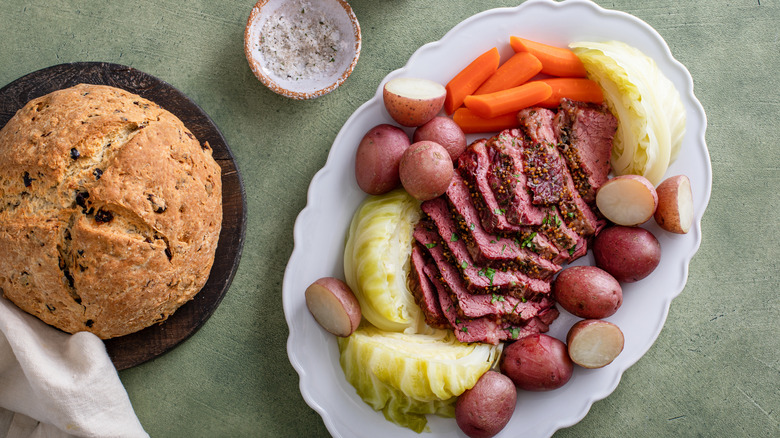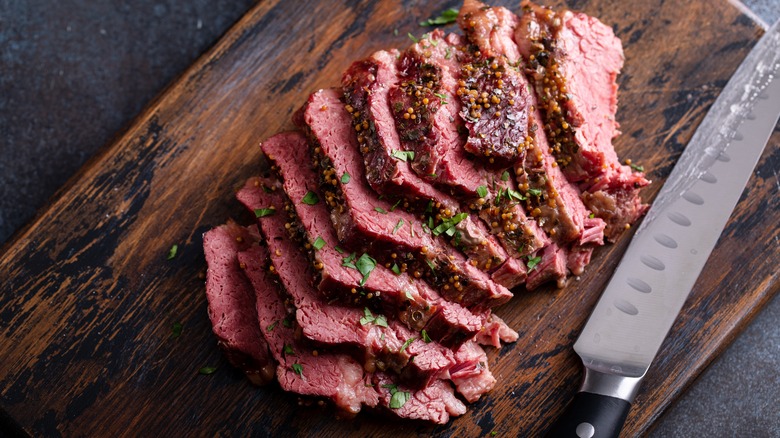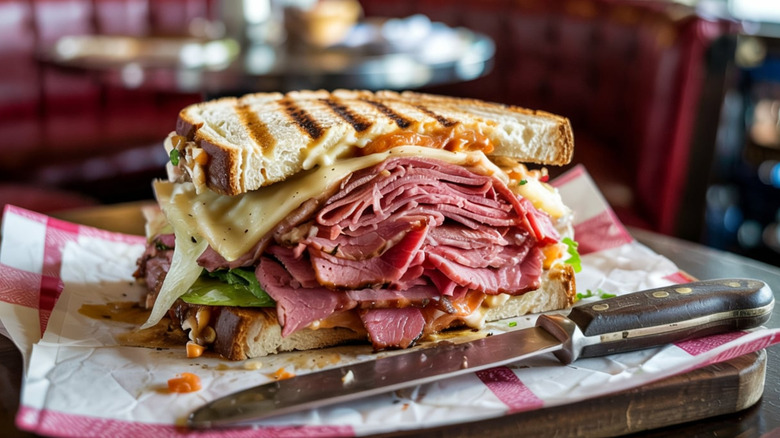Corned Beef Has No Corn - So Where Did Its Name Come From?
Rich, flavorful, and satisfyingly salty, corned beef is most famously served alongside a heaping helping of cabbage and potatoes. Thick slices of the cured meat are also commonly piled high onto rye bread and served with pickles at many Jewish deli counters. When it comes to canned corned beef, there are few preparations as satisfying as a potato- and egg-loaded corned beef hash, an American diner breakfast staple. Yet, despite the immense popularity of this delicious dish, there's often a lot of confusion about where the name comes from — especially since the dish itself has nothing to do with corn. To learn more about the history and nomenclature of corned beef, Food Republic spoke with Sarri Harper, owner of New York City's Carnegie Deli.
"The 'corn' refers to the old English word for coarse salt crystals — like kernels of corn — used to preserve meat before refrigeration," says Harper. Though the practice of salt-curing meat spans millennia, it wasn't until the mid-1600s that the term corned beef found its way into the common vernacular. In Britain, corned beef is generally considered to be the canned version of the dish, while the fresh preparation is referred to as salt beef. However, most Americans will distinguish salt beef from corned beef based on the use of spices. "Over time, spices were added [to corned beef], cooking methods refined, and brisket became the cut of choice, especially in Jewish delis," Harper says.
The history and migration of corned beef
Corned beef is a culturally significant dish for many people in the Irish, Jewish, and Caribbean diasporas due to the impacts of colonization. While corned beef is typically considered to be Irish in origin, the consumption of beef was actually quite rare in Ireland prior to British rule. Cows, which were a revered and celebrated part of the ancient Gaelic religion, were mostly raised for labor and dairy production, with only a wealthy minority accustomed to eating their meat. This changed around the 16th century, when the beef-eating British conquered most of Ireland and forced the expansion of cattle-raising to satisfy their growing cravings.
It wasn't until the Cattle Acts of the 1660s — which prohibited the export of live cattle to England — that the corned beef industry took off in Ireland. Now inundated with an abundance of affordable beef, many Irish producers began salt-curing their meat for preservation. The industry also boomed because of Ireland's low salt tax, which meant salt could be imported to the Emerald Isle for nearly 90% less than to England. Though Ireland had cornered the world's corned beef trade by the 19th century, much of what was being produced was being exported to the British empire. British naval ships were known for stocking Irish corned beef as war provisions, which allowed for the spread of the dish to colonies in the Caribbean, the Americas, and even as far as Australia.
How corned beef became an American classic
Arguments have been made that the expansion of beef production in service of the British empire was a contributing factor to the Irish potato famine. Since vast swaths of fertile land were converted to cattle farms, the dependence on potato crops deepened, which caused the decimation of these crops via disease in the 19th century to be particularly devastating. The Great Famine precipitated the migration of thousands of Irish people to the United States, where they often settled alongside another influential immigrant population: Eastern European Jews.
Since beef was more easily accessible in America, Irish immigrants began frequenting kosher butcher shops in order to purchase meat for preservation. The close proximity of the Irish and Jewish communities allowed for a culinary and cultural exchange. Many Jewish migrants were already accustomed to eating pastrami, a thoroughly spiced style of cured meat that has roots in Romanian cuisine. Despite the different cooking methods and cuts of beef used to prepare each dish, the similarities between pastrami and corned beef allowed both to become popular staples at Jewish deli counters, though some elements of pastrami-making found their way into Jewish-style corned beef. "Our New York Jewish deli-style [corned beef] is typically cured longer and spiced more heavily," says Carnegie Deli owner Sarri Harper, "then steamed for that melt-in-your-mouth texture."



